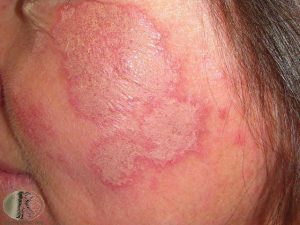
Lupus is a disease that can appear on the skin in many different ways, sometimes only affecting the skin and sometimes appearing on the skin as a symptom of systemic lupus. When lupus only affects the skin, it is called cutaneous lupus. There is subacute cutaneous lupus and there are chronic forms of cutaneous lupus. When lupus also affects other organ systems in the body, it is called systemic lupus erythematosus (SLE). SLE can be mild or severe and life threatening and can affect the joints, lungs, and kidneys, among other organs in the body. SLE is more common in women, often begins between age 15 and 45, and is more likely when someone smokes cigarettes.
Forms of cutaneous lupus:
- Discoid lupus: can cause permanent disfiguring scarring and hair loss
- Subacute cutaneous lupus (SCLE): red, circular, scaly rash usually on the chest, upper back, shoulders, and neck. Often very sensitive to sunlight.
- Acute cutaneous lupus: commonly presents as the malar or butterfly rash on the face. This form of cutaneous lupus is a manifestation of SLE.
- Lupus panniculitis: firm, deep, painful red rash due to involvement of fat under the skin, commonly on the upper outer arms and the outer thighs. Over time, this can cause dimples or depressions due to destroyed fat cells.
- Tumid lupus: a raised area of red smooth skin that is very sensitive to sunlight.
- Drug-induced lupus. This usually clears after the causative medication is stopped. This type is more common in men.
- Neonatal lupus: This can appear in babies born to mothers who have SLE. This sometimes may be associated with heart block, but otherwise the rash disappears by 6-8 months of age.

Lupus is considered an autoimmune disease. Early diagnosis is important, and your dermatologist can be very helpful in making the diagnosis. Often a skin biopsy as well as a blood sample may both be required to confirm or clarify the diagnosis. Depending on the type of lupus, your dermatologist may be the primary health care professional in charge of your treatment management or may just be part of a team that coordinates your care. Systemic lupus erythematosus is best managed by a rheumatologist. For certain forms of cutaneous lupus, your dermatologist may prescribe a corticosteroid that you may apply to your skin, take as a pill, or receive as an injection, antimalarial medication, or medication that you take as a pill that calms the activity of your immune system. These may include methotrexate cyclosporine, or mycophenolate mofetil.

If you have cutaneous lupus, it is important to apply water-resistant broad-spectrum sunscreen with SPF 30 or higher everyday, wear sun-protective clothing, seek shade when outdoors, never use a tanning bed, stop smoking, try not to scratch or pick at your skin, and replace fluorescent and halogen light bulbs with incandescent or LED.
